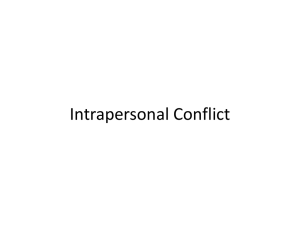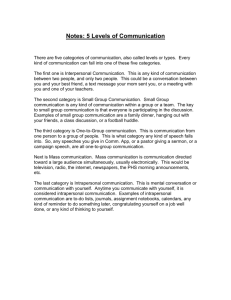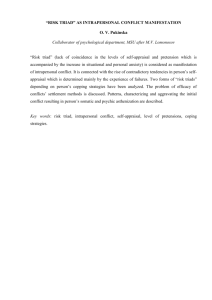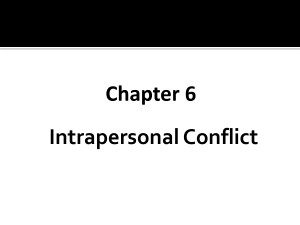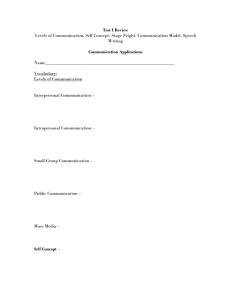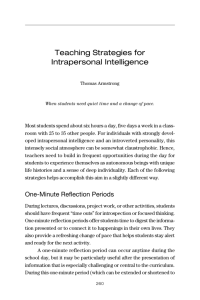Intrapersonal Conflict
advertisement
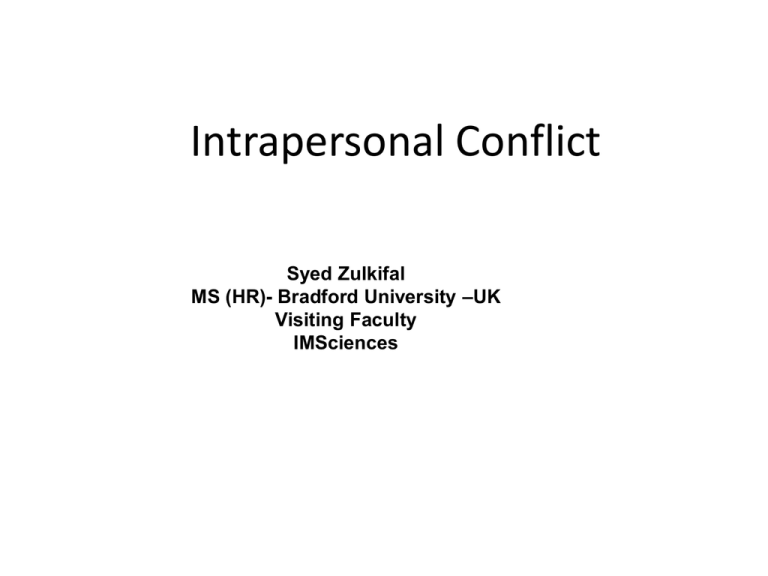
Intrapersonal Conflict Syed Zulkifal MS (HR)- Bradford University –UK Visiting Faculty IMSciences Introduction • Psychologists define conflict as; – “a situation in which a person is motivated to engage in two or more mutually exclusive activities”. • According to communication scholars – when there is incompatibility or inconsistency among an individual’s cognitive elements [which] implies that a new cognitive element is at variance with a prior explanation or expectation. • An individual is in an intrapersonal conflict, – if he or she has difficulty making a decision because of uncertainty, – if he or she is pushed or pulled in opposite directions; • conflict is a situation where oppositely directed, simultaneous forces of about equal strength occur in a person. TYPES OF INTRAPERSONAL CONFLICT • There are three types of intrapersonal conflict. • Approach–Approach Conflict – choosing between two attractive alternatives. • Approach–Avoidance Conflict – when a person feels similar degrees of attraction and repulsion. • Avoidance–Avoidance Conflict – When competing alternatives possesses negative consequences. ROLE and ROLE CONFLICT • an individual behaves with reference to the expectations that others have about the way he or she should behave, • Role represent behaviour and attitudes expected of the occupant of a given position or status, • There are at least three uses of the role; – First, role is used to mean a normative status, that includes the behaviour, attitudes, and values attributed by society to a person occupying a given position. – Second, role is used to mean an individual’s conceptualization of situation with reference to others’ positions in the society. – Third, role is used to refer to the behaviour of a person occupying a social position. ROLE CONFLICT • Role conflict is part of intrapersonal conflict, • “the simultaneous occurrence of two (or more) sets of pressures such that compliance with one would make more difficult compliance with the other” • When there is a significant mismatch between the role that a person expects to perform and the role that is demanded of the person by the organization, • when a role occupant is required to perform two or more roles that present incongruent, contradictory, or even mutually exclusive activities. Types of Role Conflict Intra-sender Conflict • when a role sender requires a role receiver to perform contradictory or inconsistent roles. Inter-sender Conflict • A role receiver experiences this type of conflict if the role behaviour demanded by one role sender is incongruent with the role behaviour demanded by another role sender(s), Inter-role Conflict • This type of conflict occurs when an individual occupies two or more roles whose expectations are inconsistent. Intra-role (Person-Role) Conflict • This type of role conflict occurs when the role requirements are incongruent with the focal person’s attitudes, values, and professional behaviour. Role Overload and Under-load • This occurs when an organizational member is required to perform a number of appropriate roles sent by different role senders, • Role overload can be classified as quantitative and qualitative, Quantitative Role overload; – refers to situations in which role occupants are required to perform more work than they can within a specific time period. Qualitative Role Overload; – refers to situations in which role occupants believe they do not possess the skills or competence necessary to perform an assignment. Quantitative under-load; – refers to a situation where employees do not have much work to do. Qualitative under-load; – refers to “lack of mental stimulation that accompanies many routine repetitive jobs”. MODEL OF ROLE CONFLICT AND AMBIGUITY CONSEQUENCES OF ROLE CONFLICT • • • • low job satisfaction, low confidence in the organization, high degree of job-related tension. Role conflict has been found to be positively related to – job dissatisfaction, – lack of job involvement and organizational commitment, – tension and anxiety – intent to leave the job, MANAGING INTRAPERSONAL CONFLICT Diagnosis • diagnosis can be performed by; – self-report, – observation, and – interview methods. Measurement • A comprehensive diagnosis of intrapersonal conflict involves the measurement as follows: 1. The amount of intrapersonal conflict. 2. The sources of such conflict. 3. Learning and effectiveness of the individual employees. Analysis • An analysis of the preceding diagnostic data should be performed to derive the following: 1. The amount of intrapersonal conflict existing in various organizational levels, units, departments, or divisions and whether they deviated from the national norms significantly. 2. Relationship between intrapersonal conflict and its sources. 3. Relationships of intrapersonal conflict to learning and effectiveness. Sources • The sources are mainly structural and are situationally imposed, • Misassignment and Goal Incongruence – If a person does not have the appropriate expertise, aptitude, and commitment, then the person may experience qualitative role overload. – there is an inverse relationship between organizational level and perception of intrapersonal conflict. • Inappropriate Demand on Capacity – If a person cannot properly satisfy position even by working at the maximum capacity, then this leads to quantitative role overload. – Inadequate role demand or qualitative role under-load is a common problem for young graduates, Contd. • Organization Structure • Organizations generate a high degree of role conflict by creating conflicting goals, policies, and decisions. • organizational practices, such as – – – – – formalization, planning activity, provision for horizontal coordination, selection based on ability, and adherence to chain of command, are all negatively related to role conflict and ambiguity. • Supervisory span (i.e., number of subordinates for whom the supervisor is charged with formal responsibility) and span of subordination (i.e., number of individuals who typically assign work to an employee) were positively associated with role conflict. Contd. • Supervisory Style – Negative relationships of role conflict to formalization, supervisory supportiveness, and team orientation. – social support from supervisors is positively associated with lower qualitative role under-load and higher quantitative role overload. – Supervisory support was (negatively) associated with role conflict, but it was not associated with role ambiguity, • Position – Role conflict is associated with positions that carry greater supervisory responsibility – organization members who were required to engage in boundaryspanning activities (i.e., make frequent outside contacts) experienced more role conflict. • Personality – Individual differences exist between the personality dispositions of internal and external locus of control. – Type A behaviour was negatively associated with qualitative role underload and positively associated with quantitative role overload. Intervention Process • Technique of Role Analysis. • Role analysis is an intervention designed to improve overall organizational effectiveness by intervening at individual, group, and intergroup levels. • this technique involves five distinct steps; 1. Purpose of Role. 2. Role Perception. 3. Expectations of Role Occupant. 4. Expectations from Role Occupant. 5. Role Profile. Structural 1. Skill variety. This refers to the degree to which a job requires a variety of activities that involve the use of a number of different skills and talents of employees. 2. Task identity. This refers to the degree to which the job requires an employee to perform a complete piece of work, that is, doing a job from beginning to end with a visible outcome. 3. Task significance. This refers to the degree to which the job has an impact on the lives or work of other people within or outside the organization. 4. Autonomy. This refers to the degree to which the job provides freedom, independence, and discretion to the employee in scheduling his or her work and in determining the procedures to be used in carrying it out. 5. Feedback. This refers to the amount of information that results from the performance of a job by an employee about how well she or he is performing. Structural Contd. • Hackman and Oldham (1975) devised the following equation for computing an overall index, the Motivation Potential Score (MPS): MPS = (Skill Variety + Task Identity+ Task Significance)/3 X Autonomy X Feedback • Three factors moderate the relationship between the core job characteristics and outcomes. These are: 1. Knowledge and skill of the employees to perform the job well. 2. Growth need strength (i.e., need for learning, self-direction, and personal growth of the employees). 3. “Context” satisfactions (i.e., the level of satisfaction, particularly with job security, compensation, co-workers, and supervision). • The employees who report higher on one or more of these moderators should respond more positively to jobs that score high on the MPS.
